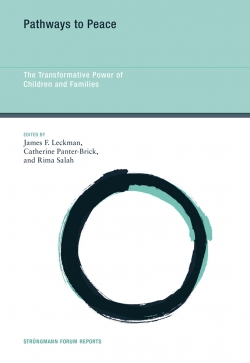Human Biological Development and Peace – Genes, Brains, Safety, and Justice
Human Biological Development and Peace – Genes, Brains, Safety, and Justice
Chapter 7 authors: Barak Morgan, Diane Sunar, C. Sue Carter, James F. Leckman, Douglas P. Fry, Eric B. Keverne, Iris-Tatjana Kolassa, Robert Kumsta, and David Olds
[In process, condense]
 Introduction
Introduction
Whereas peacemaking refers to reducing direct violence at an individual or family level, peacebuilding refers to reducing structural violence at a broader community or nation level. Neurodevelopment requires genetic templates, but the ways in which these genetic templates are used depend on the environment as mediated by epigenetic mechanisms.
Violence
The effects of direct and structural violence on genes, the brain, relationships, and the capacity for peace are the same. The two forms of violence differ only in their timeframe; structural violence is usually persistent over time and usually manifests itself in the form of poverty. Peace and violence are both relational and functional.
Environmental Becomes Epigenetically Embedded in Biology, Regulating Gene Expression
Environment Regulates Built-in Intelligence
Because gene expression is environmentally dependent, built-in intelligence can vary depending on experiences.
Embedding of Environment: Epigenetic Changes, Sensitive Periods, and Canalization
Some genes can be permanently “turned on” or “turned off” and passed down during a sensitive period in early life. Canalization refers to the fact that, after this sensitive period, the gene is resistant to environmental influences.
Threat and Stress in Brain Development
The Stress Response
The stress response is affected by two systems activated by the corticotrophin release factor: the sympathetic nervous system and the hypothalamic-pituitary-adrenal (HPA) axis.
“Top-down” and “Bottom-up” Brain Processes: Self Regulation
Top-down regulation refers to cortical structures integrating a wide range of information in order to make sophisticated assessments. Because this process is voluntary and slow, bottom-down regulation might be necessary. This second form of regulation refers to the subcortex overriding top-down cortical control in situations where time is scarce, eliciting an urgent, automatic response such as a fight-or-flight impulse.
Self-regulation and Socioeconomic Status
Diminished top-down self regulation is associated with low socioeconomic status, especially in the earliest postnatal years.
From Maternal Regulation to Self-regulation: The Maternal Mediation Hypothesis
In most cases, poor childhood self-regulation is a stronger predictor of poor outcomes in adulthood than is socioeconomic status. However, maternal responsiveness and care have been found to mediate self-regulation in children.
Strategic Life Histories
Once-off canalization of the stress response may serve to prepare children for adult environments. In safe environments, mothers invest many resources and offspring develop strong top-down regulation. In stressful environments, mothers invest fewer resources and offspring develop a more sensitive stress response.
For Better or For Worse: Individual Differences in Sensitivity to the Environment
Not all offspring follow the same trajectory in response to the same environment. Transgenerational inheritance of canalized development trajectories can occur in many ways.
Environmental Regulation of Thread-related Built-in Intelligence
Safety in the Brain: The Role of Others
The environment of the child includes many “others”: parents, caretakers, relatives, and more. Behavioral synchrony between mothers and infants leads to psychological synchrony. Social interactions permit not only adaptive responses critical in the face of threats but also the use of cues associated with safety to allow growth, restoration, and development of critical social skills and social affiliations.
Childhood Adversity and Life-time Trauma Exposure
The number of traumatic event types experienced by a child affects the risk and severity of PTSD symptoms.
Parental Mediation in Traumatic Stress
In war-torn societies, mass trauma and domestic violence have a large impact on children and families. Traumatized parents can negatively affect a child’s mental and physical health.
Distinct Models Regulate Build-in Intelligence Differently
Relational Models in Early Development
Four models for building relations include communalism, hierarchy, equality, and proportionality. Infants show strong attachment to caretakers before the end of the first year of life, and failure to experience trust in infancy can lead to difficulties in establishing and maintaining relationships later in life.
Altruism in Early Childhood and Evolution
Humans exhibit kin selection and reciprocal altruism, but studies have also shown that altruism in early childhood is not related to kinship and reciprocity. Helping and sharing behaviors are spontaneous and in absence of an expected reward or reciprocation.
Groups: Environments of Social Development
Group acceptance and status within groups are important for each individual child, as children accept group identities quickly.
Neurobiology of Groups and Shared States
Some hypothesize that the human cortex evolved to its current size and intelligence level at least partially in response to the cognitive demands of complex group environments. For instance, brain networks can exhibit synchronization between individuals in groups.
Can Formative Childhood Be a Path to Peace?
There are two major hurdles in the path between experience in early childhood and peacebuilding. The first paradox stems from the ultimate dependence of development on the environment; essentially, adverse environments regulate for lower parental investment, and this, in turn, regulates evolved built-in intelligence in offspring to manifest in deeply embedded, strongly canalized bottom-up accelerated developmental trajectories characterized by impulsiveness, diminished empathy, and diminished investment in more offspring—traits that factor reproductive survival under adverse conditions. The second paradox stems from the relative independence of the relational models from one another, with the result that peacemaking inclinations and abilities that are supported or useful in one model may be irrelevant or even counterproductive in others. Peacebuilding has a positive impact on early childhood development, while peacemaking has relatively little effect on reducing direct and structural violence.
Basic Motivations and Capacities that Can Be Mobilized by Interventions
Targeting preschool and early education experiences are examples of good interventions, and interventions that bring together parents from diverse backgrounds are also effective. Interventions that fail to change parental behavior are of limited value.
The Way Forward
The way forward should include greater investment in early childhood development as well as greater investment of parents in their children. We should strive for high quality, long-term peacemaking efforts at the family level for whole communities; this is peacebuilding.
JOIN THE CONVERSATION
For breaking news and to stay connected, follow us on social media. Sign up to get our E-News delivered straight to your inbox.

